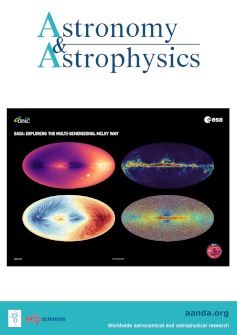Erosion of a dense molecular core by a strong outflow from a massive protostar
IF 5.4
2区 物理与天体物理
Q1 ASTRONOMY & ASTROPHYSICS
引用次数: 0
Abstract
Context. Molecular outflows from massive protostars can impact the interstellar medium in different ways, adding turbulence on different spatial scales, dragging material at supersonic velocities, producing shocks and heating, and physically impinging onto dense structures that may be harboring other protostars.Aims. We aim to quantify the impact of the outflow associated with the high-mass protostar GGD 27-MM2(E) on its parent envelope and how this outflow affects its environment.Methods. We present Atacama Large Millimeter/submillimeter Array Band 3 observations of N2H+ (1–0) and CH3CN (5–4), as well as Band 7 observations of the H2CO molecular line emissions from the protostellar system GGD 27-MM2(E). Through position–velocity diagrams along and across the outflow axis, we studied the kinematics and structure of the outflow. We also fit extracted spectra of the CH3CN emission to obtain the physical conditions of the gas. We use the results to discuss the impact of the outflow on its surroundings.Results. We find that N2H+ emission traces a dense molecular cloud surrounding GGD 27-MM2(E). We estimate that the mass of this cloud is ~13.3–26.5 M⊙. The molecular cloud contains an internal cavity aligned with the H2CO-traced molecular outflow. The outflow, also traced by CH3CN, shows evidence of a collision with a molecular core (MC), as indicated by the distinctive increases in the distinct physical properties of the gas such as the excitation temperature, column density, line width, and velocity. This collision results in an X-shaped structure in the northern part of the outflow around the position of the MC, which produces spray-shocked material downstream in the north of MC, as observed in position–velocity diagrams both along and across the outflow axis. The outflow has a mass of 1.7–2.1 M⊙, a momentum of 7.8–10.1 M⊙ km s−1, a kinetic energy of 5.0–6.6×1044 erg, and a mass-loss rate of 4.9–6.0×10−4 M⊙ yr−1.Conclusions. The molecular outflow from GGD 27-MM2(E) significantly perturbs and erodes its parent cloud, compressing the gas of sources such as the MC and ALMA 12. The feedback from this powerful protostellar outflow helps maintain the turbulence in the surrounding area.求助全文
约1分钟内获得全文
求助全文
来源期刊

Astronomy & Astrophysics
地学天文-天文与天体物理
CiteScore
10.20
自引率
27.70%
发文量
2105
审稿时长
1-2 weeks
期刊介绍:
Astronomy & Astrophysics is an international Journal that publishes papers on all aspects of astronomy and astrophysics (theoretical, observational, and instrumental) independently of the techniques used to obtain the results.
 求助内容:
求助内容: 应助结果提醒方式:
应助结果提醒方式:


